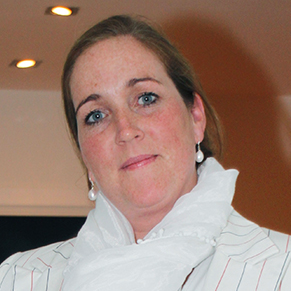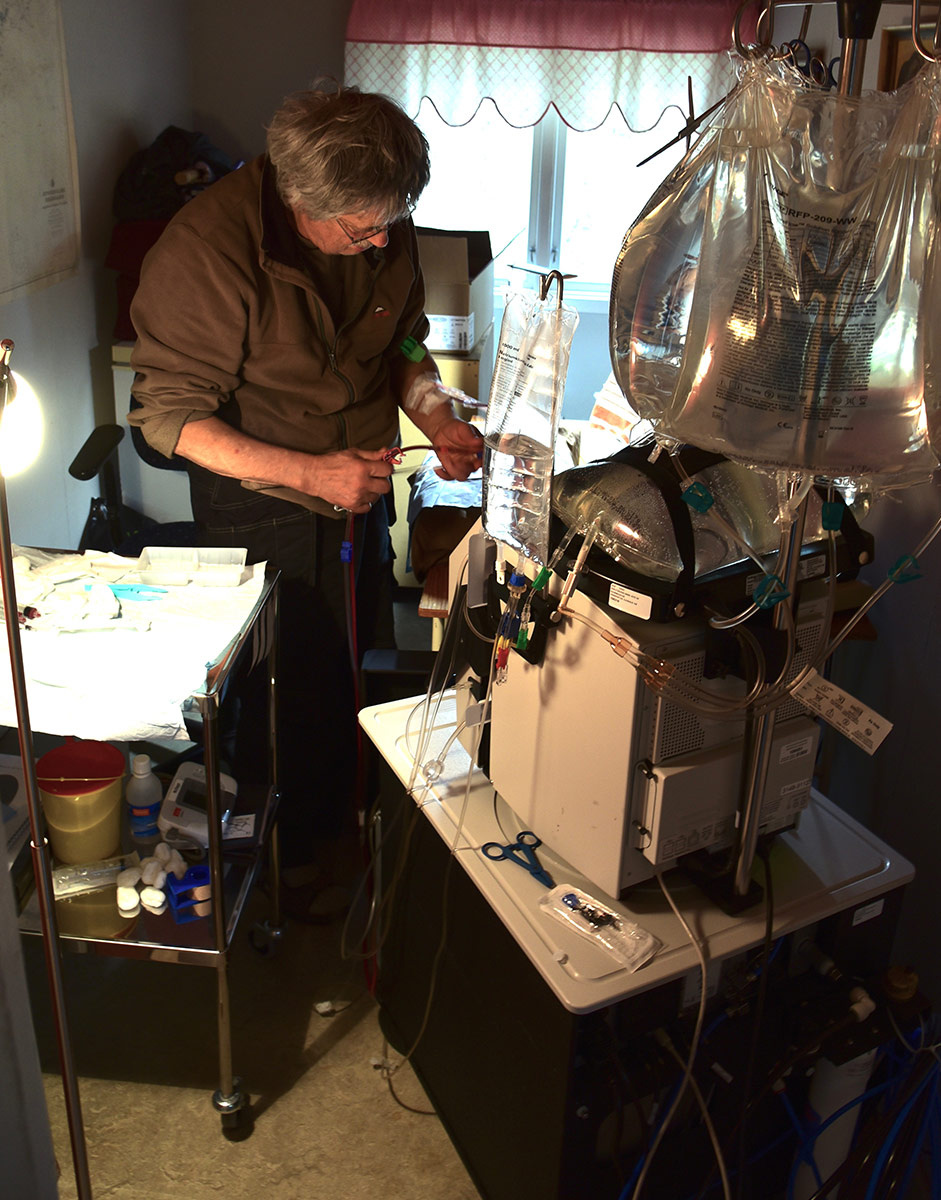







Sophie Halldin
RN, Renal Unit in Haemodialysis Department, Danderyds Sjukhus AB
Stockholm, Sweden
elsahalldin@yahoo.se
3.0 The Benefits of Frequent Dialysis
Learning Outcomes
- To understand the clinical benefits of HHD and frequent dialysis
- To understand why patients often describe an improved quality of life with HHD
- To determine the effect of frequent dialysis on blood parameters
Introduction
There are many perceived benefits of Home Haemodialysis (HHD), and many correlate with significant improvements in health outcomes. The benefits may be due to both clinical and psychosocial effects of HHD:
- In the home environment, patients enjoy the very important benefit of increasing the frequency of dialysis treatments and possibly extending the duration of sessions or at least cumulative hours of dialysis per week.
- The patient manages treatment, so adherence improves; the patient experiences increased self-esteem and regains control of his or her health and life.
- Compared to conventional haemodialysis HHD patients experience increase freedom. The time that previously was put into traveling and waiting to receive dialysis treatment at the clinic can now be devoted to socializing with family and friends, as well as spending time on leisure activities and work, particularly if dialysis occurs overnight1.
However, the patient must consider that HHD is more than a lifestyle choice and that there might be situations in which risks may outweigh benefits. Dialysis is always a balancing act between benefits and risks, and this form of therapy is not for everyone2. In this chapter, we will take you through the benefits. It is important to remember there are also disadvantages to HHD and all patients may not experience all benefits (see “Benefits and Risks” at the end of this chapter).
3.1 Improved health
Patients who undergo HHD instead of conventional haemodialysis have reported significant improvements in their physical health. These improvements can become more evident over time29.
3.1.1 Better control of fluid balance
- Frequent dialysis reduces weight gain between dialysis sessions. Patients report less thirst. Better volume control reduces Left Ventricular Mass (LVM) which is associated with mortality and cardiovascular morbidity3,4,5.
- With less fluid to remove at each session, ultrafiltration can occur more gradually resulting in less cramping and episodes of hypotension during dialysis1.
- Blood pressure declines. This is one of the most consistent benefits of HHD in randomized and non-randomized studies alike. A reduction in fluid overload seems to be the main mechanism for blood pressure reduction with HHD4,5.
3.1.2 Improved blood biochemistry
The kidney has many functions which means that many different biochemical parameters are adversely affected when the kidneys stop functioning. With dialysis, these improve and with frequent dialysis further improvements are seen. “The more you dialyze, the more you clean”6.
- Efficient clearance of urea, creatinine, uric acid and Beta-2-microglobulin.
- Increased removal of phosphorus with more hours of haemodialysis per week4,30.
- Reduction in inflammatory markers31.
3.1.3 Improvement in nutritional status
- Reduced need for dietary restrictions24,25,30.
- Improved appetite24,25.
3.1.4 Decreased medication burden
Dialysis patients typically take many prescription medications, many of which are very expensive. The improved physical health associated with more frequent HHD is often accompanied with a reduced need for medications.
- Patients have improved blood pressure control and can decrease or even avoid antihypertensive medications26,30.
- Patients with lower serum phosphorus due to more dialysis may have significantly reduced need for phosphorus binders (especially with nocturnal HD7).
- The required dose of erythropoietin may decrease8,9.
3.1.5 Improved pregnancy outcomes
Pregnancy in women with end stage renal disease on renal replacement therapy is uncommon due to the physiologic changes associated with renal failure as well as the complexities and risk involved in managing these patients. For those able to conceive, intensified haemodialysis (HD), through longer and/or more frequent haemodialysis sessions, offers improved maternal and neonatal outcomes10.
Nocturnal HD (NHD) has been associated with delivery of infants with higher weights born at more advanced gestational ages, as well as fewer maternal and fetal complications. These encouraging results suggest a greater role for much more intensive dialysis in pregnancy11.
3.1.6 Survival
More frequent HHD is associated with improvements in patient survival, compared to Conventional Haemodialysis (CHD)12. On average, patients on HHD live four years longer than patients on CHD13. Several studies have compared survival on Short-Daily Haemodialysis (SDHD), Home Haemodialysis (HHD), Nocturnal Haemodialysis (NHD), and Conventional Haemodialysis (CHD). In general, the survival results have been higher for SDHD, HHD and NHD4,12. Recent data, taken mainly from the Frequent Haemodialysis Network (FHN) Daily Trial with 245 patients randomly assigned to either 6 or 3 in-centre haemodialysis sessions per week for 12 months, demonstrates reduced left and right ventricular end systolic and diastolic ventricular volumes as well as reduced left ventricular mass index5,15.
Other observational studies report
- A reduction in mortality risk equal to 7% for every 30-min increase in dialysis treatment time16.
- The long-term survival on frequent HHD is good and has improved over time. More frequent HHD may represent a good alternative to a deceased-donor kidney transplant for certain patients13,4.
3.2 Enhanced Quality of Life
Most patients with end-stage kidney disease experience several physical, mental, and psychosocial problems that have a major impact on quality of life (QoL). They place enormous value on their Health-Related Quality of Life (HRQoL), more so than even survival, and want to know how their HRQoL will be affected by their choice of dialysis modality17.
3.2.1 Tools to measure Quality of Life
There are a number of tools that can be used to measure quality of life. In the FHN Daily Trial, results showed higher scores for more frequent versus conventional HD using four tools18;
- Feeling thermometer – a single question that asks patients to rate their own health on a visual analog scale from 0 to 100, where 0 is dead and 100 is perfect health.
- A general health scale – 5 items from the RAND KDQoL SF-36 questionnaire.
- Time to recover from a dialysis session.
- Health Utilities index (The Health Utilities Index Mark 3) – a commonly used and validated survey in which participants rate their health on the following 8 attributes: vision, hearing, speech, ambulation, dexterity, emotion, cognition and pain.
3.2.2 Recovery Time
One of the most striking changes noted with frequent HD is that recovery time or post dialysis fatigue was reduced and that patients could return to normal daily activities shortly after completion of treatment17,19.
3.2.3 Improved vitality and energy
Improvements in patient reported vitality and energy have been seen20. There is improvement in sex-related hormones which can improve the quality of sexual relationships27.
3.2.4 Improved sleep quality
A variety of sleep disturbances are commonly noted in dialysis patients, and may well contribute significantly to fatigue, morbidity, and impairment of QoL. The impact of NHD on sleep patterns is an obvious concern. However, preliminary studies have suggested that NHD results in only a small reduction in total sleep time; however, there is a dramatic improvement in episodes of sleep apnea and hypopnea20,19,28.
3.2.5 Changed mental capacity
Previous data from the FREEDOM study indicated significant improvement in depression scores after initiation of more frequent HHD17,19. This study also reported an improvement in the mental component score and all mental sub-domains of the RAND SF-3620. There is also an improvement in mental well-being. Patients felt healthier and reported fewer interactions with their physician21.
3.2.6 Freedom
Patients experience increased freedom because they control their own times for dialysis. They are able to take responsibility for their own health and can choose how to balance dialysis with work. They experience an improvement in generalized well-being which may be due to increased autonomy19.
3.3 Patient experiences and quotes
Improvements in biochemical parameters and observations are less important if there is not a perceived gain in QoL for the patient. The quotes below are positive personal opinions of HHD.
“I can do it on my own and I don´t want other people to help me” 22
“Really enjoyed the freedom of when I can do my dialysis to fit around my life. It has given me back my independence”
“The center had too many nurses and traveling techs…the things that I saw! You´re locked down four hours three days a week. Your friends are hanging out …and here I am, 5.00 on Friday, headed to a dialysis unit…at home, you can build it around your schedule…I´ve got a lot of control back in my life. My energy level is up” 22
“I knew I would never survive in-center hemo. I had to sleep for 6, 7 hours afterwards. I could never, ever feel okay…You don´t see a hope…I was so very depressed. Even when I took antidepressants, it didn´t help…I was so drained. Now…I feel a lot more hope. It has really made a difference in how I view everything. I can enjoy the day. I try to get out and do something every day” 22
“After in-center treatments, I’d be really whipped, we could not go out. I saw home-hemo as a new beginning. And we saw benefits early on in doing it at home. I have energy so we can go out on nights after my treatments” 22
“No one knows how a person feels except the person themselves. I do it [frequent HHD] how I want within the guidelines of the system” 23
3.4 Summary of the benefits of HHD
Potential Benefits of More Frequent HHD
| Increased clearance of B2-microglobulin, possibly lowering risk of dialysis-related amyloidosis1 |
| Increased removal of phosphorus, along with significant reduction in phosphate binder dose2,3 |
| Reduction in inflammatory markers, such as C-reactive protein4 |
| Improvement in erythropoiesis-stimulating agent responsiveness5 |
| Increased weekly standardized Kt/V7 |
| Better control of fluid volume, including less interdialytic weight gain8 |
| Improved control of blood pressure, with reduced need for antihypertensive medications9 |
| Significant reduction in left ventricular mass6,7 |
| Increased ejection fraction10 |
| Less cramping and episodes of hypotension during dialysis9 |
| Minimal "washed out" feelings after dialysis sessions11,12 |
| Improvement in symptoms of restless leg syndrome13 |
| Improvement in nutritional status, with lesser need for dietary restrictions14 |
| Improved sleep quality13 |
| Fewer episodes of sleep apnea per night15 |
| Reduction in FGF-2316 |
| Improvement in depressive symptoms11,17 |
| Improvement in sex hormone levels18 |
| Successful pregnancy outcomes19 |
| Improvement in vascular smooth muscle cell function20 |
| Enhanced health-related quality of life6,7,21 |
| Increased life expectancy22,23 |
Benefits and risks of frequent Home Haemodialysis (HHD)
Despite the health benefits that more frequent HHD may provide to those with chronic kidney disease, this form of therapy is not for everyone. HHD with the NxStage System One requires a patient and partner who are committed to being trained on and following the guidelines for proper system operation.
The reported benefits of HHD may not be experienced by all patients.
The NxStage System One is a prescription device and, like all medical devices, involves some risks. The risks associated with haemodialysis treatments in any environment include, but are not limited to, high blood pressure, fluid overload, low blood pressure, heart-related issues, and vascular access complications. The medical devices used in haemodialysis therapies may add additional risks including air entering the bloodstream, and blood loss due to clotting or accidental disconnection of the blood tubing set. Patients should consult with their doctor to understand the risks and responsibilities of home and/or more frequent haemodialysis using the NxStage System One.
Certain risks are unique to the home. Treatments at home are done without the presence of medical personnel and on-site technical support. Patients and their partners must be trained on what to do and how to get medical or technical help if needed.
Certain risks associated with haemodialysis treatment are increased when performing nocturnal therapy due to the length of treatment time and because therapy is performed while the patient and care partner are sleeping. These risks include, but are not limited to, blood access disconnects and blood loss during sleep, blood clotting due to slower blood flow or increased treatment time or both, and delayed response to alarms when waking from sleep. Patients should consult with their physician to understand the risks and responsibilities associated with home nocturnal haemodialysis using the NxStage System One.
Learning Activity
- What is the main mechanism for blood pressure reduction with HHD?
- Which substances have improved clearance on frequent dialysis?
- In what way is quality of life affected by HHD?
- Why is there often a decrease in medications when on HHD?
Acknowledgements
We would like to say Thank You to the patients who provided the quotes and photos of their dialysis at home.
EDTNA/ERCA Secretariat
E-mail: secretariat@edtnaerca.org










